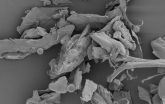Home sweet microbe: Dust in your house can predict geographic region, gender of occupants
2015-08-26
(Press-News.org) The humble dust collecting in the average American household harbors a teeming menagerie of bacteria and fungi, and as researchers from the University of Colorado Boulder and North Carolina State University have discovered, it may be able to predict not only the geographic region of a given home, but the gender ratio of the occupants and the presence of a pet as well.
The new findings, which were published today in the journal Proceedings of the Royal Society B, highlight the impressive amount of microbial diversity in the average household and the degree to which these organisms can tell a story about the homes they inhabit.
"Every day, we're surrounded by a vast array of organisms in our homes, most of which we can't see," said Noah Fierer, an Associate Professor in the Department of Ecology and Evolutionary Biology at CU-Boulder and a co-author of the study. "We live in a microbial zoo, and this study was an attempt to catalog that diversity."
The study examined roughly 1,200 homes across the continental U.S. Volunteers participating in the Wild Life of Our Homes citizen science project helped researchers collect indoor and outdoor dust samples at each site.
On average, each home contains more than 5,000 different species of bacteria and around 2,000 species of fungi. Fungal communities tend to be more predictive of a home's location while bacterial communities provide clues about the identity of its residents.
"Geography is the best predictor of fungi in your home," said Fierer, who is also a research fellow at the Cooperative Institute for Research in Environmental Sciences (CIRES) at CU-Boulder. "The reason is that most fungi blow in from outdoors via soil and leaves," he said, noting that a home in the upper Midwest, for instance, will harbor distinct fungi compared to a home in the Southeast.
When it comes to bacteria, however, where you live may be less important than whom you live with. From the dust samples, researchers could confidently predict which homes had pets such as cats or dogs and, to a slightly lesser extent, the gender ratio of the residents. Homes with only male occupants, for example, will have a different bacterial makeup than those with both male and female occupants.
"One of the key takeaways is that if you want to change what you breathe inside your house, you would either have to move very far away or change the people and the pets you live with," said Albert Barbarán, a graduate researcher in CU-Boulder's Department of Ecology and Evolutionary Biology and lead author of the study.
The findings may have future implications for forensic investigations and allergen research.
INFORMATION:
The study was co-authored by Rob Dunn, Associate Professor of Biological Sciences at North Carolina State University (NCSU); Brian Reich, Associate Professor in the Department of Statistics at NCSU; Krishna Pacifici, Research Assistant Professor in the Department of Applied Ecology at NCSU; Eric Laber, Assistant Professor in the Department of Statistics at NCSU; Holly Menninger, Director of Public Science for the College of Sciences at NCSU; Shelly Miller, Professor in the Department of Mechanical Engineering at CU-Boulder; James Morton, a former graduate researcher in the Department of Interdisciplinary Qualitative Biology at CU-Boulder; and Jessica Henley and Jonathan Leff, both graduate researchers in the Department of Ecology and Evolutionary Biology at CU-Boulder.
The National Science Foundation provided funding for the research, with additional support from the A.P. Sloan Microbiology of the Built Environment Program and the Personal Genomes Project.
[Attachments] See images for this press release:

ELSE PRESS RELEASES FROM THIS DATE:
2015-08-26
Dutch research shows that trained detectives of specialized observation teams are much better at registering details of a drug deal than ordinary civilians. Previous legal-psychological research revealed no relevant differences in observation skills between police professionals and civilians. The findings have been published in Legal and Criminological Psychology.
Judges and juries often assume that police officers' statements are more reliable than those of regular eyewitnesses. Because of this assumption, police officers' statements typically carry more weight in legal ...
2015-08-26
Only one in five gay and bisexual teen boys have been tested for HIV
HIV infections are on the rise for young men who have sex with men
Text messages, online program can identify nearby confidential testing sites
Testing in schools would 'normalize' the process.
CHICAGO --- Young men who have sex with men have the highest risk for HIV infection, but only one in five has ever been tested for HIV, a much lower rate than testing for non-adolescents, reports a new national Northwestern Medicine study conducted in partnership with the Center for Innovative Public ...
2015-08-26
On the coral reef, knowing who's your friend and who's your enemy can sometimes be a little complicated.
Take seaweed, for instance. Normally it's the enemy of coral, secreting toxic chemicals, blocking the sunlight, and damaging coral with its rough surfaces. But when hordes of hungry crown-of-thorns sea stars invade the reef, everything changes, reports a study to be published August 25 in the journal Proceedings of the Royal Society B.
Seaweeds appear to protect coral from the marauding sea stars, giving new meaning to the proverb: "The enemy of my enemy is my friend." ...
2015-08-26
Lecithin is an ingredient that you've probably never heard of, but one that plays a vital role in the production of chocolate and many other foods. It's never been clear how this ingredient works on a molecular level, and confectioners have relied on observational methods - essentially trial and error - to perfect their recipes.
Now, scientists have shown how the field of molecular dynamics (simulation on a molecular level) could be a valuable tool in understanding chocolate conching - the part of the chocolate-making process where aromatic sensation, texture and 'mouthfeel' ...
2015-08-26
Diseases of the heart and blood vessels are the most common cause of death in Europe, resulting in over four million deaths a year (45% of all deaths) according to the latest available figures published today (Wednesday) in the European Heart Journal [1].
Although deaths from cardiovascular disease (CVD) are declining in most of Europe, there are large inequalities between European countries, with higher death rates seen in Eastern Europe. These high death rates correspond to the lower life expectancy also found in these countries, indicating the impact of CVD on inequalities ...
2015-08-26
Doctors in Togo, West Africa have seen a 10% drop in tuberculosis death rates after redesigning diagnosis and treatment services in one of the country's health districts.
The full results are published in BMJ Quality Improvement Reports today - an open access forum to help clinicians share improvement ideas.
Tuberculosis (TB) is the second leading cause of death among infectious diseases worldwide, killing nearly 2 million people each year, mostly in less developed countries.
Even though there have been improvements in tuberculosis control over the past two decades, ...
2015-08-26
For the first time, UK physicians have demonstrated that antiviral-based therapies have the potential to protect humans from the deadly Ebola virus. The report, published in The Lancet Infectious Diseases journal, describes a case-series of eight British health-care workers who were evacuated to the Royal Free Hospital in London, UK after possible accidental exposure to Ebola virus in Sierra Leone between January and March 2015.
Four of the health-care workers were considered to have been at significant risk of exposure to Ebola from needlestick injuries and were given ...
2015-08-26
A new study from The Journal of Neuroscience shows that humans and rhesus monkeys have very similar abilities in recognizing objects "at a glance," validating the use of this animal model in the study of human visual perception. In the study, published August 26, humans and monkeys not only demonstrated similar ease in recognizing objects in varied positions and landscapes, but both species also tended to make the same errors.
For the study, researchers from MIT compared the performance of two rhesus macaque monkeys and 638 adult human subjects on a large set of object ...
2015-08-26
Baltimore, Md., August 25, 2015 - Malawi has a population of 16 million, yet, only one inpatient rehabilitation center for individuals with stroke, spinal cord injury, and similar conditions. With just 40 beds, the Kachere Rehabilitation Center in Blantyre, Malawi's second largest city, provides services to the entire country. Because there is little funding for rehabilitation in the country, there is essentially no rehabilitation and follow-up services for patients after they return to their families, homes, and communities.
Leslie B. Glickman, PT, PhD, an assistant ...
2015-08-25
DALLAS, Aug. 25, 2015 -- Smokers who quit after having a heart attack have similar levels of chest pain and mental health as non-smokers, according to research in the American Heart Association journal Circulation: Cardiovascular Quality and Outcomes.
Researchers assessed 4,003 adults in two U.S. multi-center heart attack patient registries for smoking, chest pain and health-related quality of life measures, such as physical and mental components at admission, at one, six and 12 months after their heart attacks.
At admission, patients were identified as those who never ...
LAST 30 PRESS RELEASES:
[Press-News.org] Home sweet microbe: Dust in your house can predict geographic region, gender of occupants

